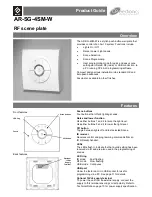
AT90S/LS2333 and AT90S/LS4433
86
Typical Characteristics
The following charts show typical behavior. These data are characterized, but not tested. All current consumption measure-
ments are performed with all I/O pins configured as inputs and with internal pull-ups enabled. A sine wave generator with
rail to rail output is used as clock source.
The power consumption in power-down mode is independent of clock selection.
The current consumption is a function of several factors such as: operating voltage, operating frequency, loading of I/O
pins, switching rate of I/O pins, code executed and ambient temperature. The dominating factors are operating voltage and
frequency.
The current drawn from capacitive loaded pins may be estimated (for one pin) as C
L
*
V
CC
*f where C
L
= load capacitance,
V
CC
= operating voltage and f = average switching frequency of I/O pin.
The parts are characterized at frequencies higher than test limits. Parts are not guaranted to function properly at frequen-
cies higher than the ordering code indicates.
The difference between current consumption in Power Down mode with Watchdog timer enabled and Power Down mode
with Watchdog timer disabled represents the differential current drawn by the watchdog timer.
The difference between Power Down mode with Brown Out Detector enabled and Power Down mode with Watchdog timer
disabled represents the differential current drawn by the brown out detector.
Figure 70. Active Supply Current vs. Frequency
0
5
10
15
20
25
30
35
0
1
2
3
4
5
6
7
8
9
10
11
12
13
14
15
ACTIVE SUPPLY CURRENT vs. FREQUENCY
T = 25˚C
A
V
cc
= 6V
V
cc
= 5.5V
V
cc
= 5V
V
cc
= 4.5V
V
cc
= 4V
V
cc
= 3.6V
V
cc
= 3.3V
V
cc
= 3.0V
V
cc
= 2.7V
Frequency (MHz)
I
cc
(mA)
















































